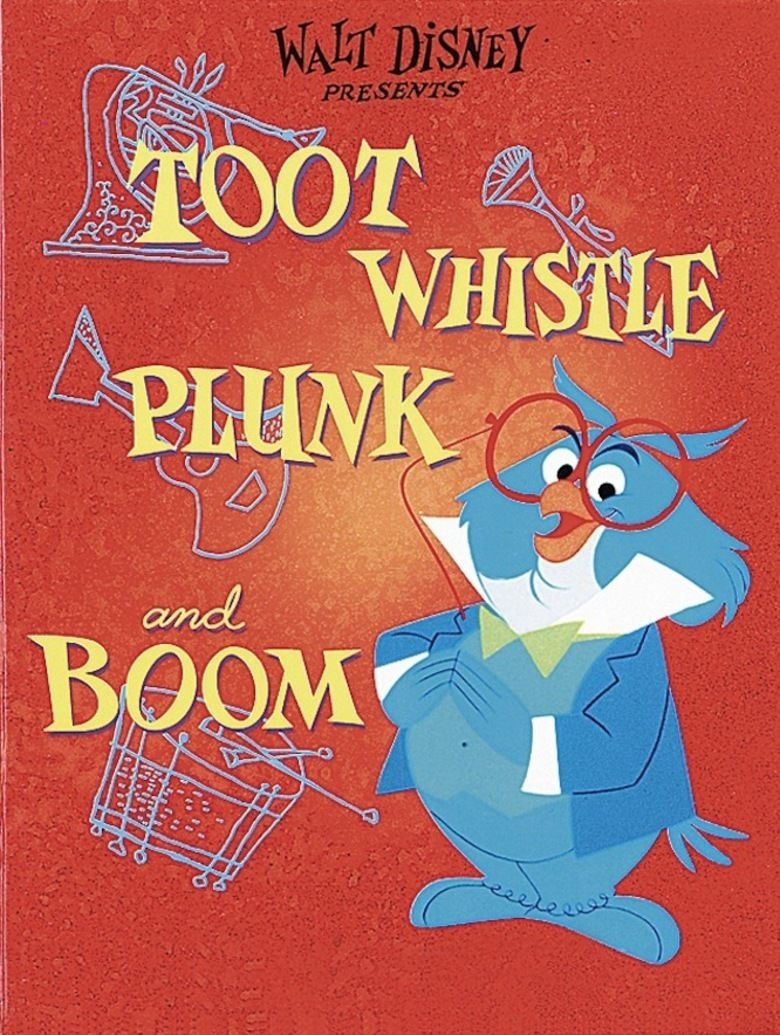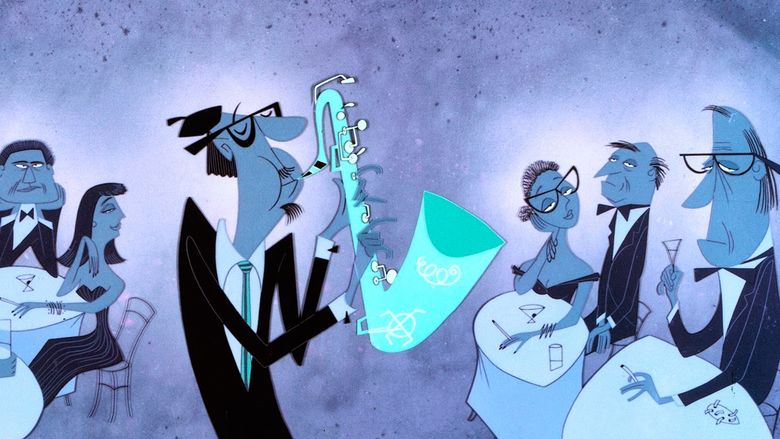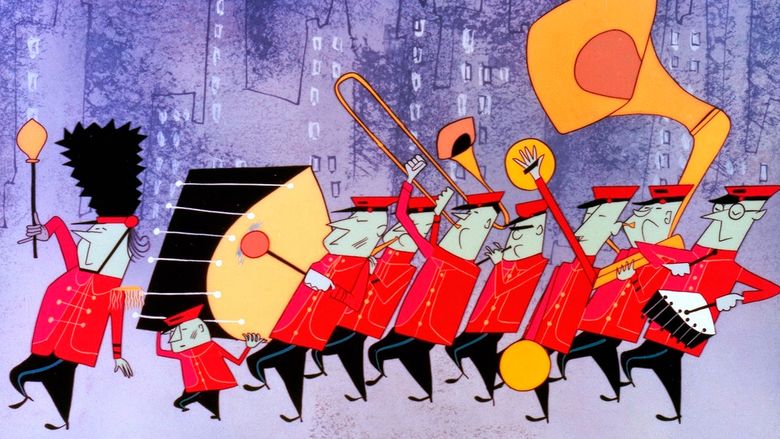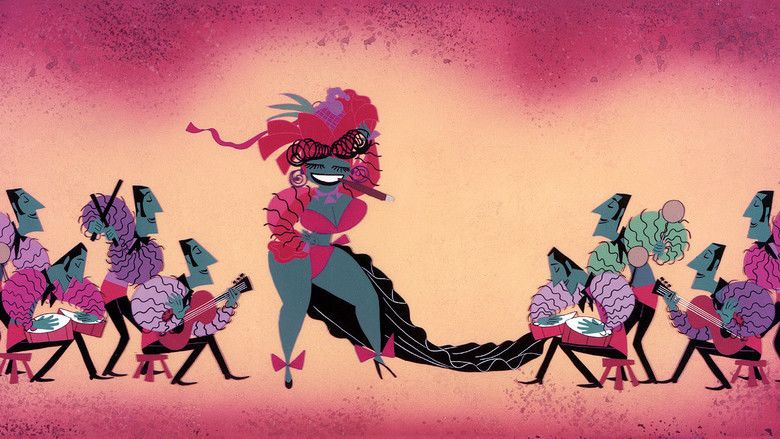Toot, Whistle, Plunk and Boom
7.4 /10 1 Votes
Duration | 7.2/10 IMDb Genre Animation, Short, Comedy Language English | |||||||||||||||||||||||||||||||||
 | ||||||||||||||||||||||||||||||||||
Director Ward KimballCharles A. Nichols Release date November 10, 1953 Awards Academy Award for Best Short Film (Animated) Cast (Professor Owl / Bertie Birdbrain), (Penelope Pinfeather), (Susy Sparrow), (The Mellomen) Similar movies Alpine Climbers , Mickey's Polo Team , Hawaiian Holiday , Mickey's Grand Opera , Mickey and the Beanstalk , Beach Picnic Tagline A crash course on the history of Western musical instruments. | ||||||||||||||||||||||||||||||||||
Toot, Whistle, Plunk and Boom is an educational Adventures in Music animated short film produced by Walt Disney Productions, and originally released to theaters by Buena Vista Distribution on November 10, 1953. A sequel to the first Adventures in Music cartoon, the 3-D short Melody, Toot, Whistle, Plunk and Boom is a stylized presentation of the evolution of the four orchestra sections over the ages with: the brass ("toot"), the woodwind ("whistle"), the strings ("plunk"), and the percussion ("boom").
Contents
- Disney 53 toot whistle plunk and boom
- Synopsis
- Toot
- Whistle
- Plunk
- Boom
- Conclusion
- Alternate versions
- Re releases and educational use
- Voices
- References

The first Disney cartoon to be filmed and released in widescreen CinemaScope, Toot, Whistle, Plunk and Boom won the 1954 Academy Award for Best Short Subject (Cartoons). In 1994, it was voted #29 of the 50 Greatest Cartoons of all time by members of the animation field.

Disney 53 toot whistle plunk and boom
Synopsis

The credits roll over a stylised music shop. The names of cast and crew and title of the feature are superimposed over the various instruments and instrument cases. The scene then cuts to Professor Owl, who rushes to the schoolhouse full of his fine feathered students as a drumroll is played on a snare.

A brief musical section introduces us to "the subject for today": the study of musical instruments. Professor Owl explains to the class (and the viewer) that all music originates from four core sounds: toot (brass), whistle (woodwind), plunk (strings) and boom (percussion).
Toot

The film then jumps to a group of four cavemen, each of whom have discovered the nuclear form of one of the above sounds. We begin with a portly Caveman Toot who has discovered that blowing through an old cow's horn produces a pleasing "toot". We advance to ancient Egypt in 2000 BC, where Caveman Toot discovers that metal horns produce even better sounds. He celebrates by breaking into a two-note jazz solo as Egyptian characters painted on the walls boogie down.
We return to Professor Owl, who explains that making a trumpet longer made its tone lower. We then visit a Roman trumpeter who crashes into a column and bends his horn into a grotesque shape... however, he soon discovers that despite this change in form, the trumpet does not sound any different: it is possible to change the horn's shape without changing the pitch.
However, as Professor Owl explains, this horn can only produce certain notes; in order to get all of the notes required for even a simple tune, you would need four horns of different lengths. But if we create a horn with valves, we can effectively have four horns in one, and this fact is celebrated with another jazz solo.
Whistle
We return to the cavemen, where Caveman Whistle is trying to impress his "cavegirl" by blowing on a tube of grass; he further discovers that adding holes to the tube allows him to modify the "whistle" in interesting ways (the more holes Whistle adds the longer the grass tube gets and he invents the first flute). The cavegirl is impressed, but then a rival caveman appears, bonks the cavegirl on the head with his club, and drags her off by the hair (which makes Caveman Whistle angry).
Professor Owl explains that this system of holes is the basis for every woodwind instrument, including the clarinet played by Johann Sebastian Bach and the saxophone played by a beatnik.
Plunk
Caveman Plunk has discovered that plucking on the string of his bow produces a pleasant "plunk" sound. An offscreen choir explains (as the animation shows) how to create a simple harp from Caveman Plunk's bow by adding a jar to make a resonator, adding some extra strings, changing the jar to a box of wood, sliding it down and adding tuning pegs, and rearranging it all (and Plunk invents the first harp).
Professor Owl mentions that you can either pluck the harp, or play it with a bow. We then briefly visit several periods in history, where we see several stringed instruments being played in similar fashion, and finish with a string quartet.
Boom
Caveman Boom hits his stomach to produce a "boom", and hits other things with his hand and his club to make other sounds. Professor Owl escorts us through history and explains how a variety of percussion instruments emerged from this basic theory, ranging from rattles to complex drum kits and even the bass drums of marching bands.
Conclusion
The chorus recaps that all music, from the trombone to the calliope to the banjo to Latin percussion to "music oriental" to an orchestra in a concert hall, emerge from the four core sounds with Caveman Toot in the brass section, Caveman Whistle in the woodwind section, Caveman Plunk in the string section and Caveman Boom in the percussion section, all wearing top hats.
Alternate versions
Like many of Disney's early CinemaScope films, a "flat" version shot in 4:3 ratio was made for theaters that were not equipped for CinemaScope. This required rearranging the artwork for some shots to accommodate the smaller screen. Shots of multiple repeated characters (like the bird chorus at the end, for instance) were cut in half, using two repetitions instead of four. The most notable change comes at the transition from the end of the "Boom" section to the parade that starts the finale. In the CinemaScope version, the background and characters fade out, leaving the drum in the last scene alone; the drum then jumps from the side of the screen to the centre, and the parade fades in. In the flat version, the camera zooms in on the drum, dissolving into the parade and zooms back out.
Other changes occur in the flat version.
Black stereotypes have been cut from this short for the DVD release.
Re-releases and educational use
Toot, Whistle, Plunk and Boom was reissued in 1963 as a companion short to that year's theatrical re-release of Fantasia. The short is available on two Disney DVD sets: it is a bonus feature on the Fantasia 2000 DVD, and is one of the selected shorts included in the Walt Disney Treasures set Disney Rarities: Celebrated Shorts, 1920s–1960s.
In 1962, Disney issued a re-recorded and expanded version of the short's music and voices on vinyl LP entitled "A Child's Introduction to Melody and the Instruments of the Orchestra." Thurl Ravenscroft provided the voice of the owl on the album.
While the film was originally released into theatres as a part of a broader collection of shorts, it continues to be used today in music classrooms to provide an elementary understanding of how musical instruments work.
Voices
References
Toot, Whistle, Plunk and Boom WikipediaToot, Whistle, Plunk and Boom IMDb Toot, Whistle, Plunk and Boom themoviedb.org
